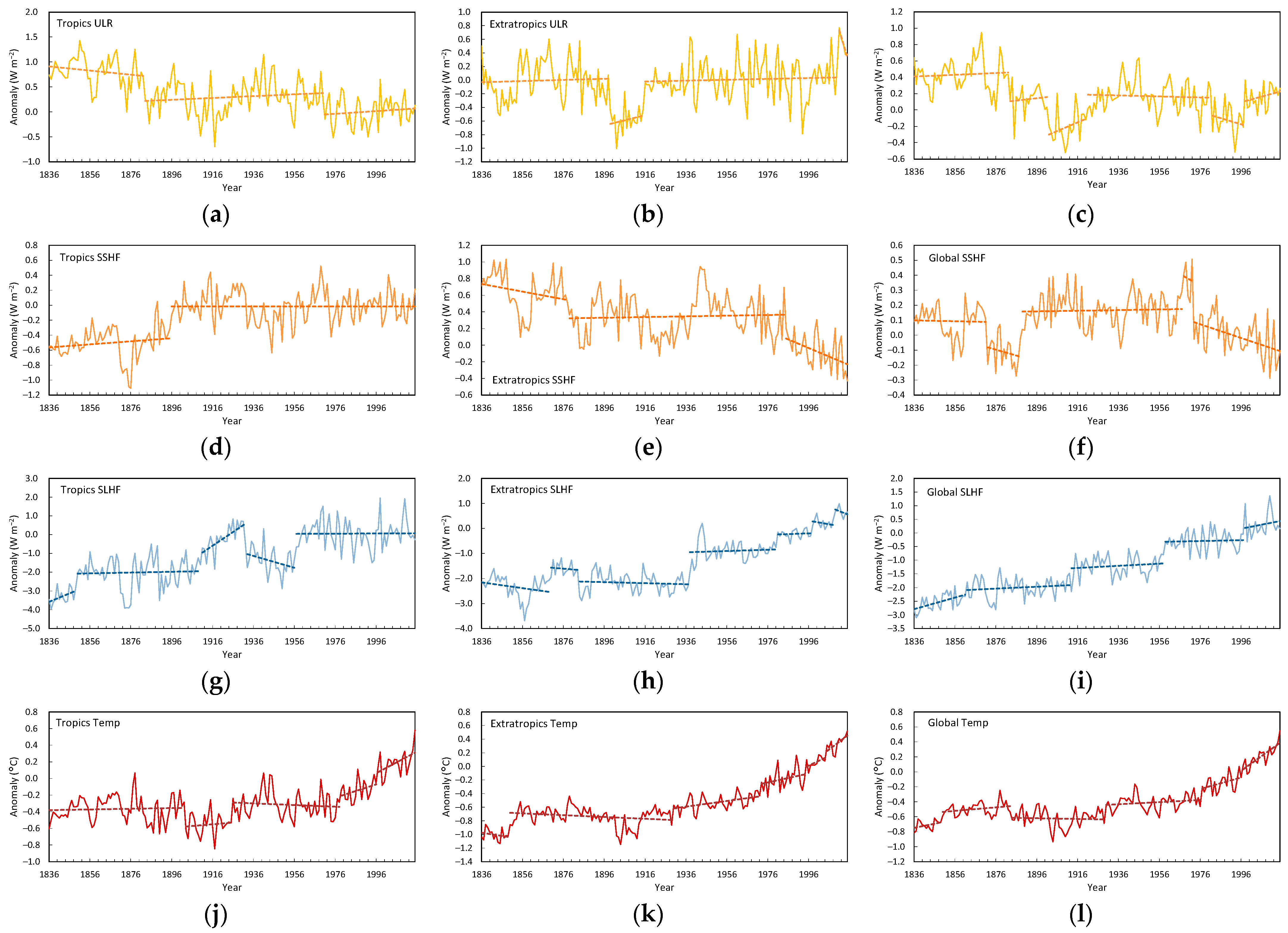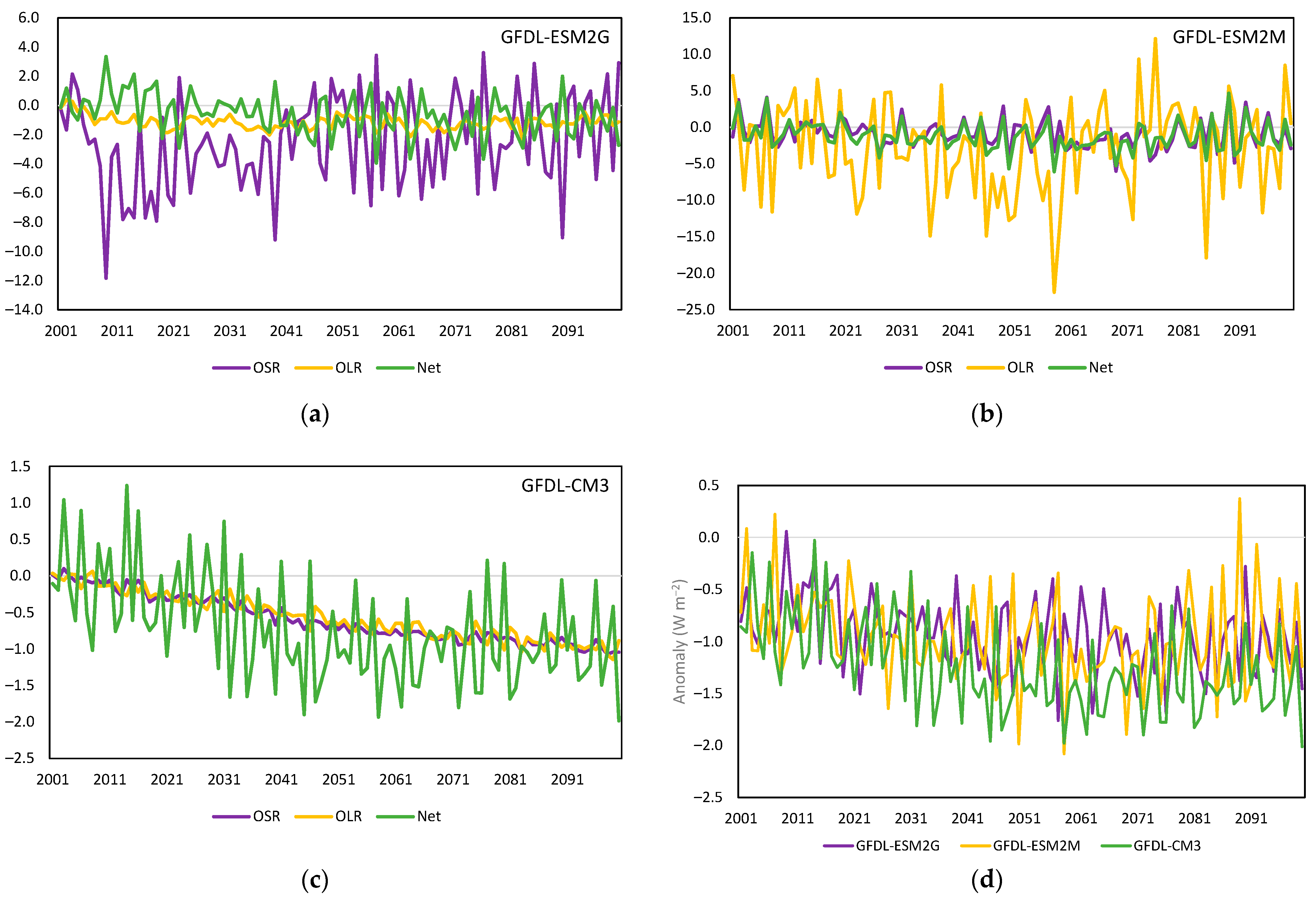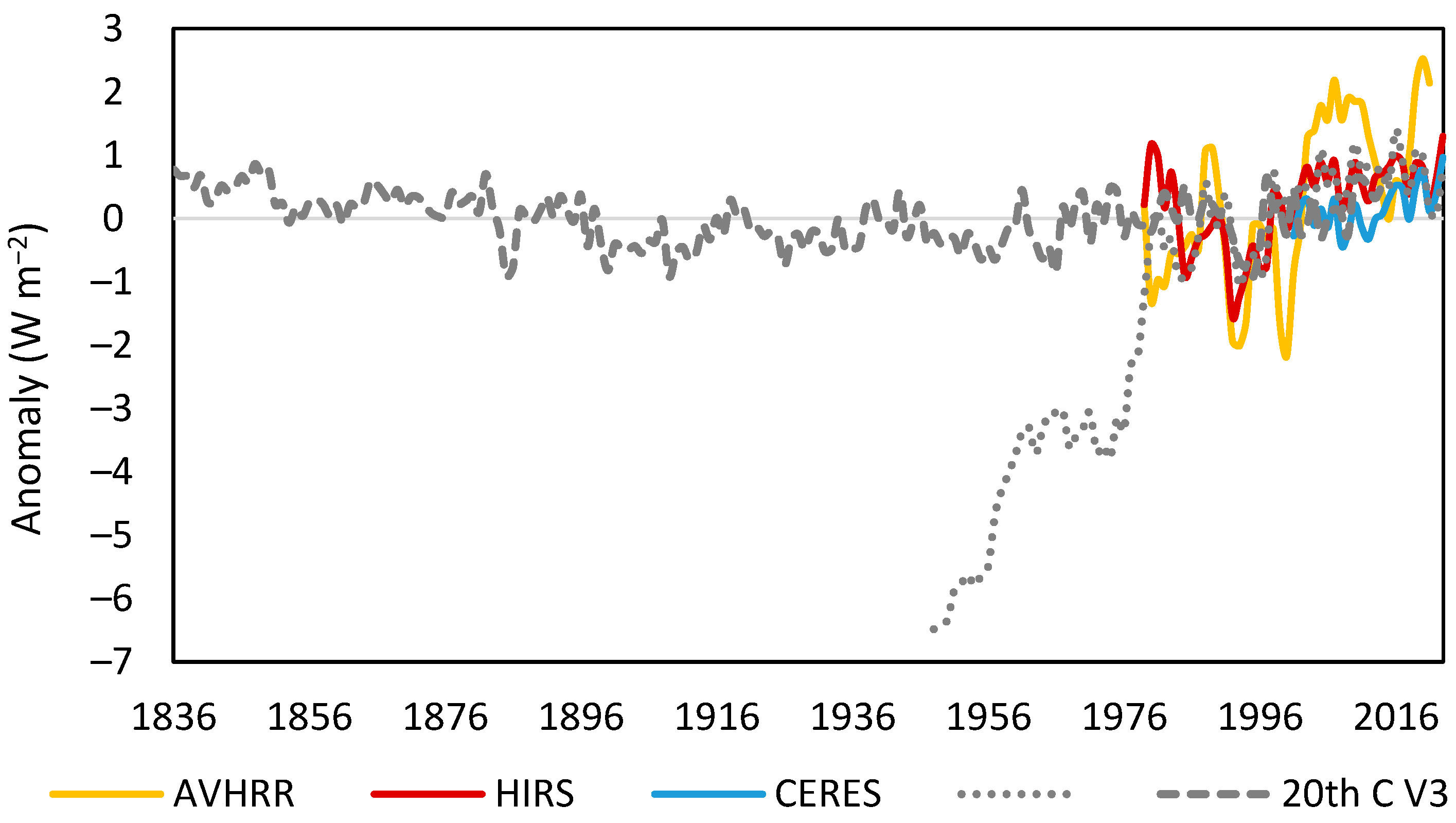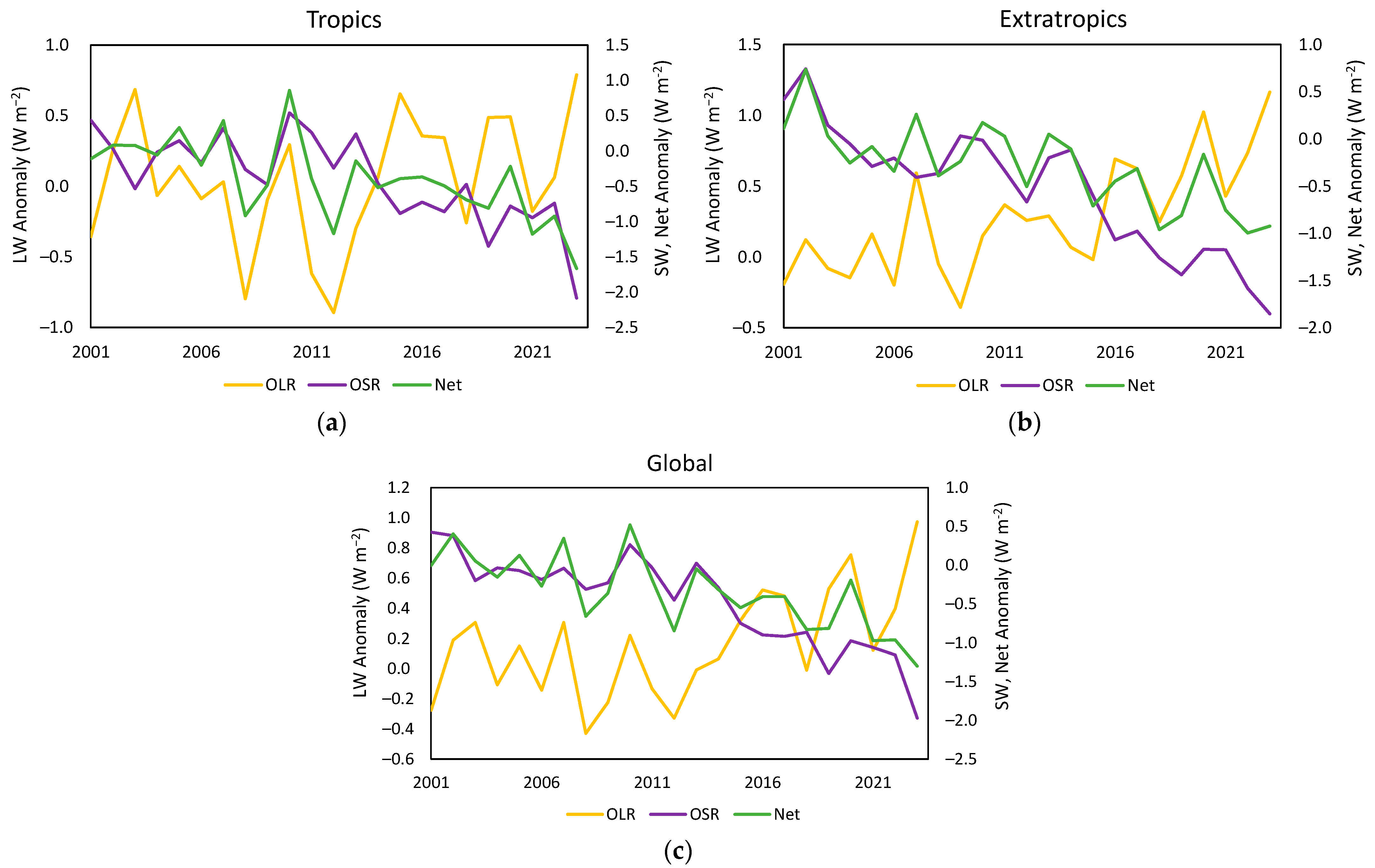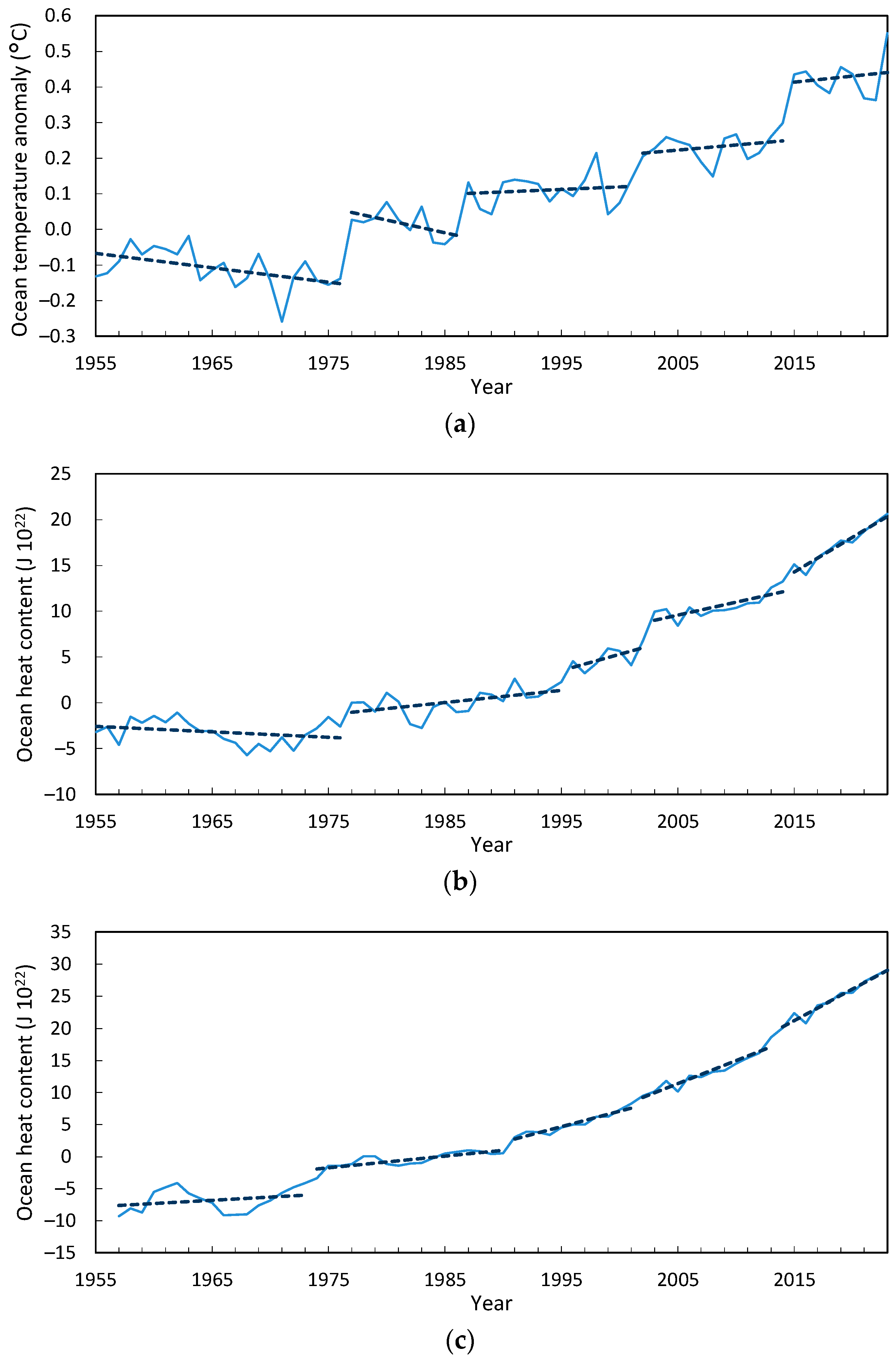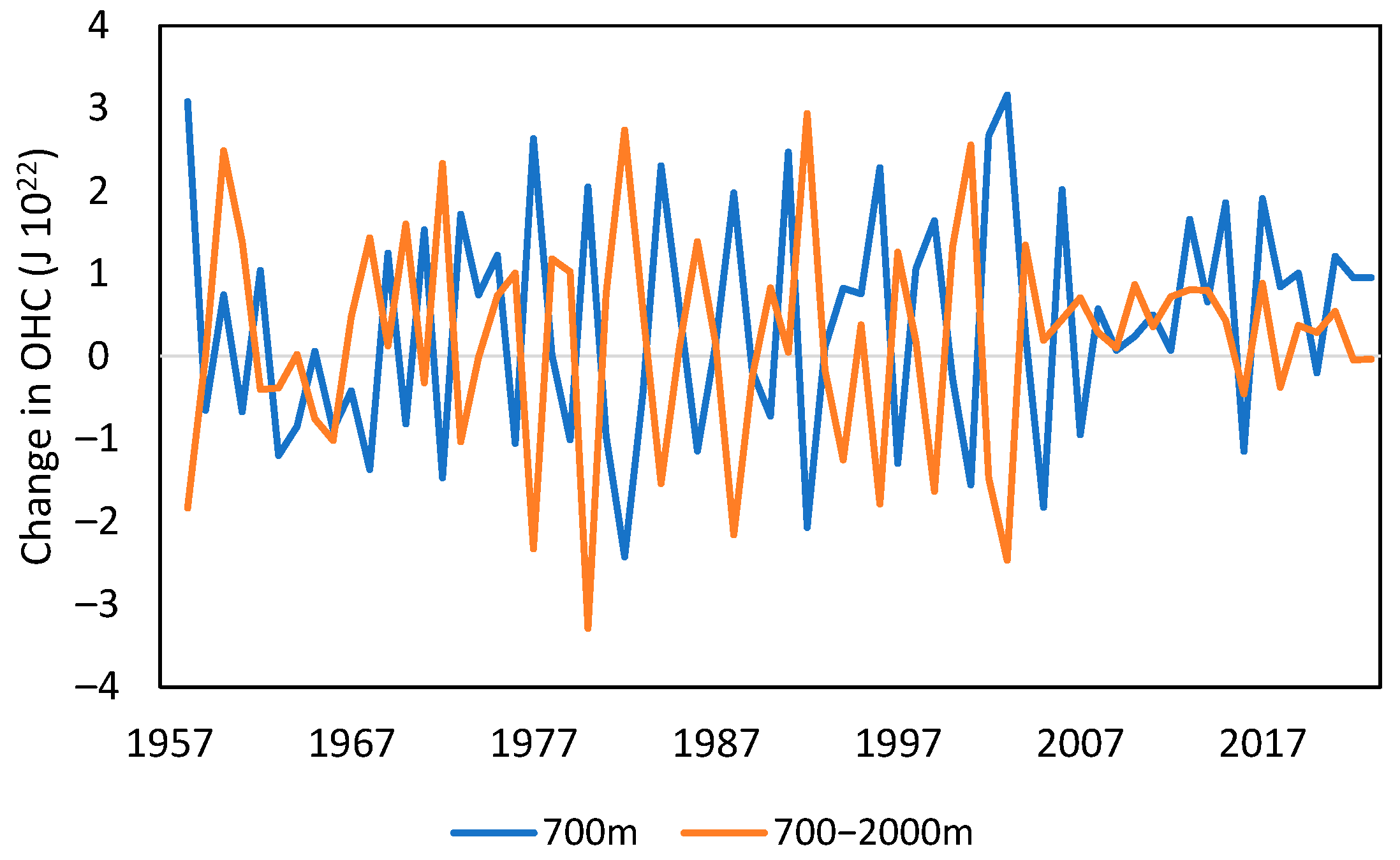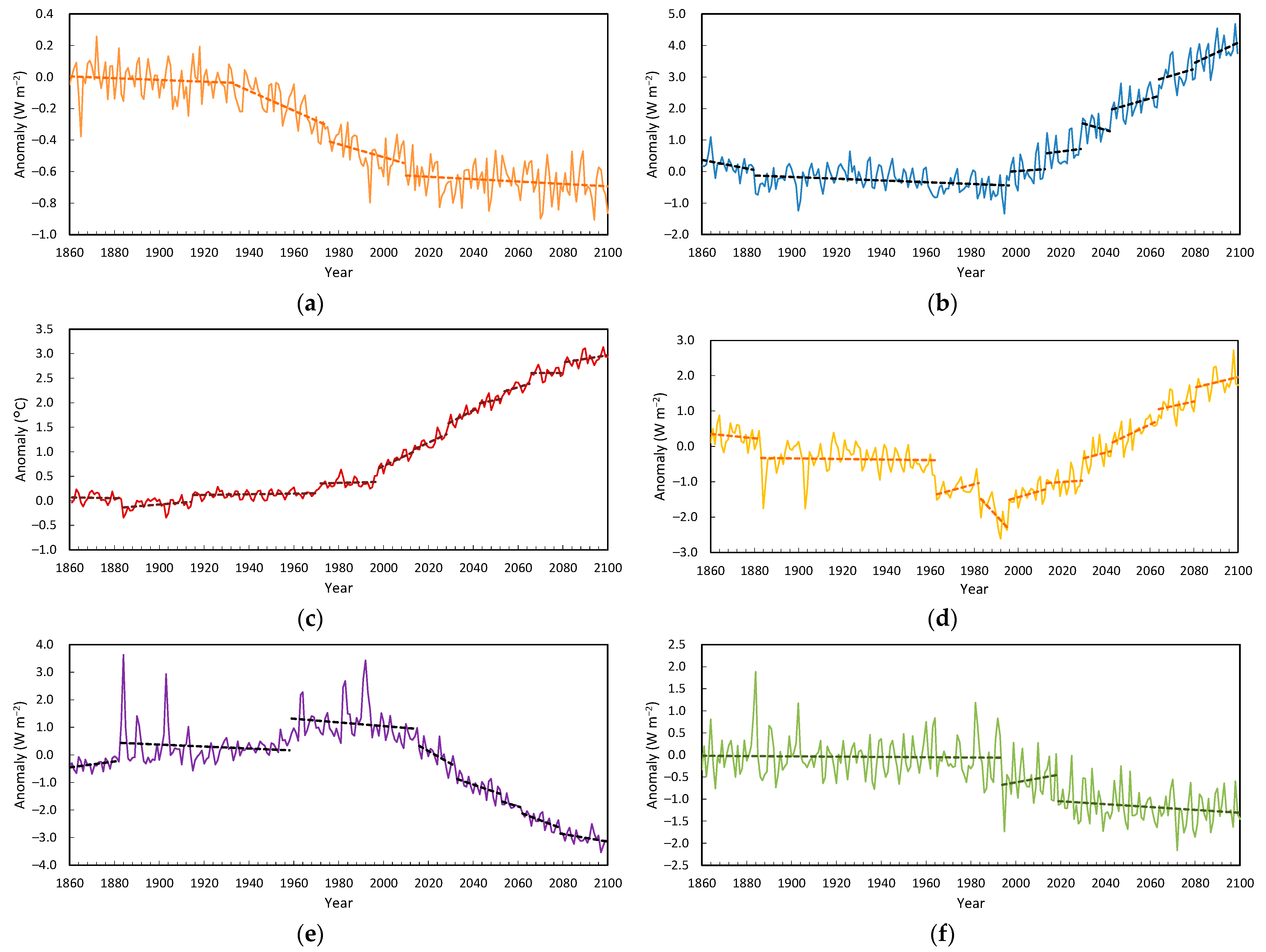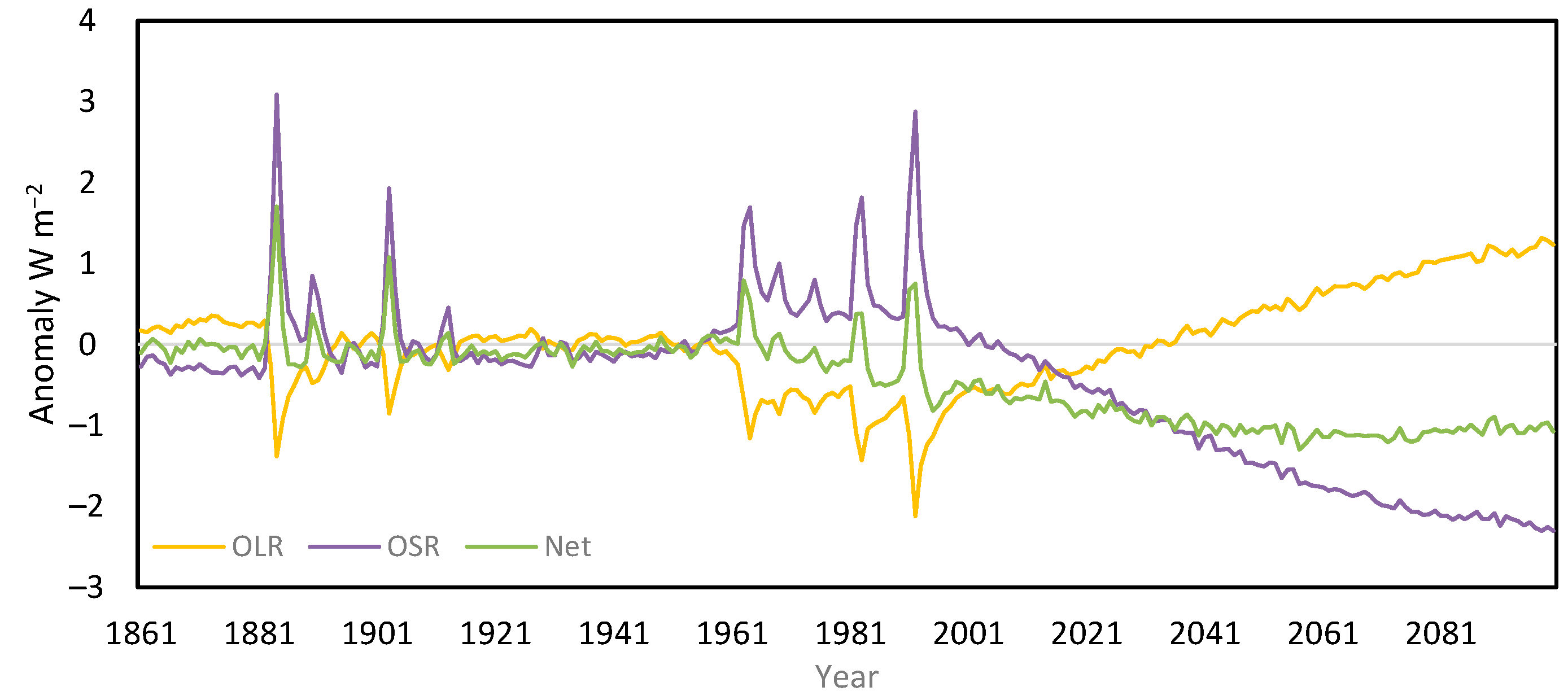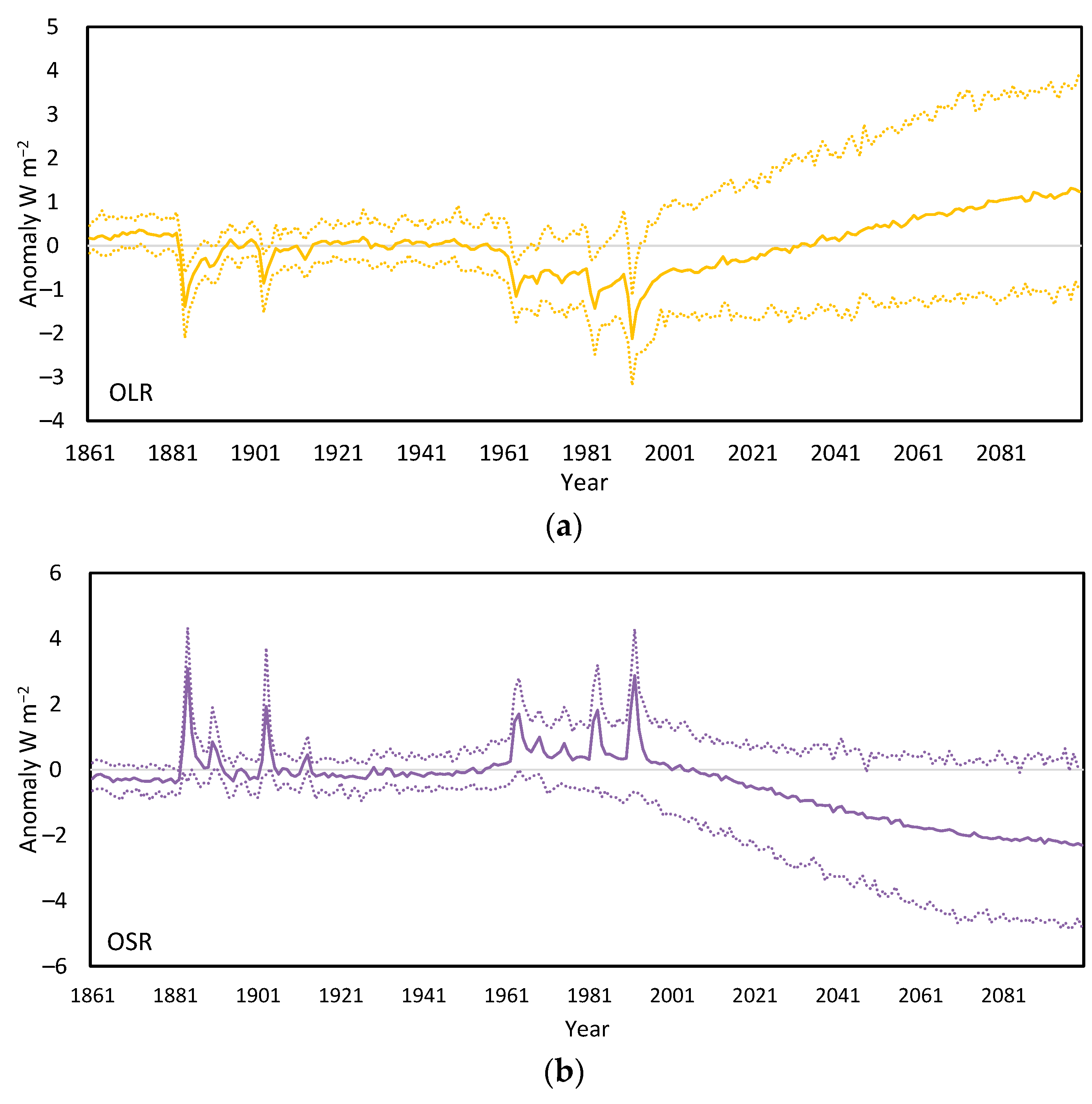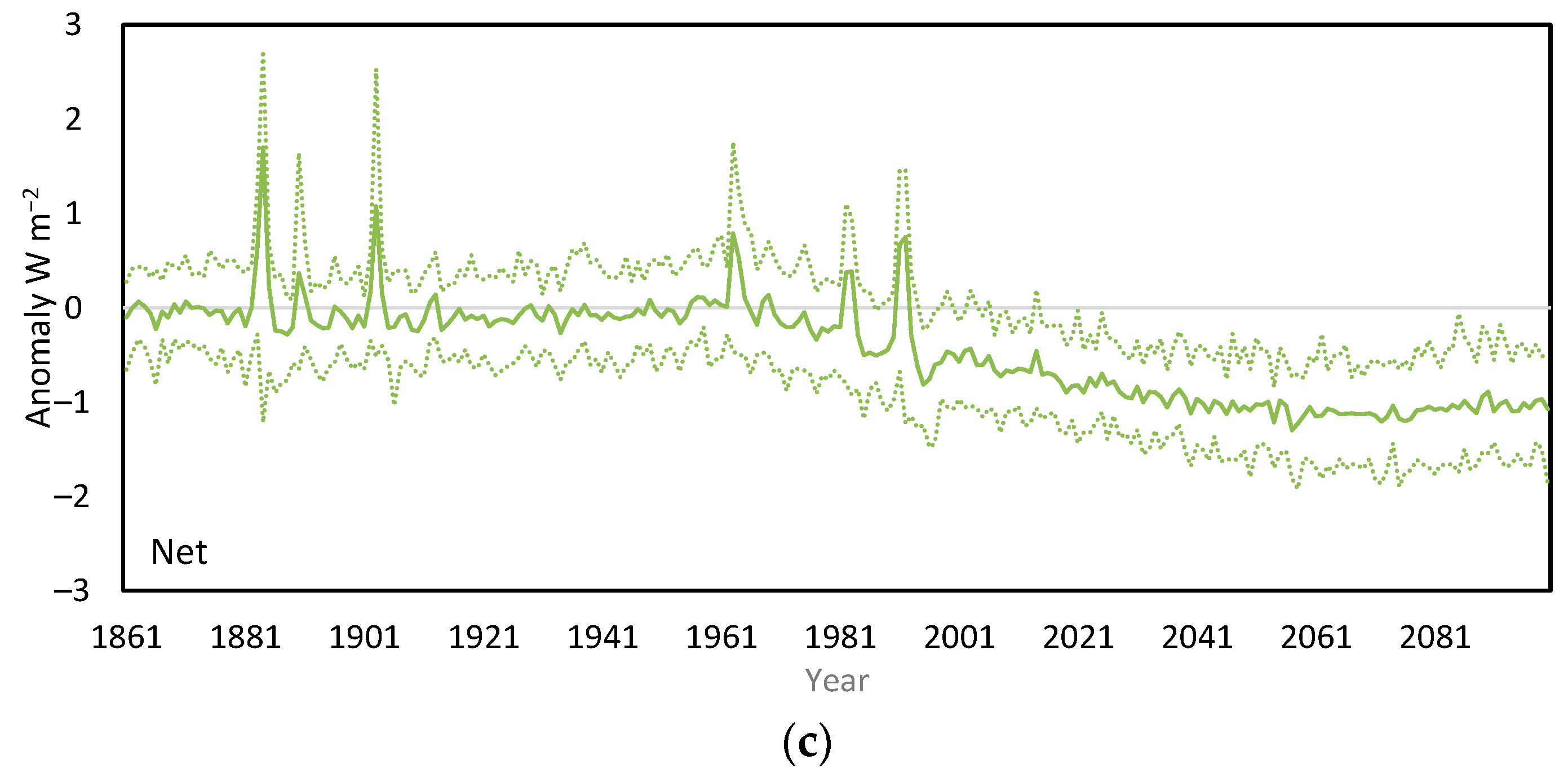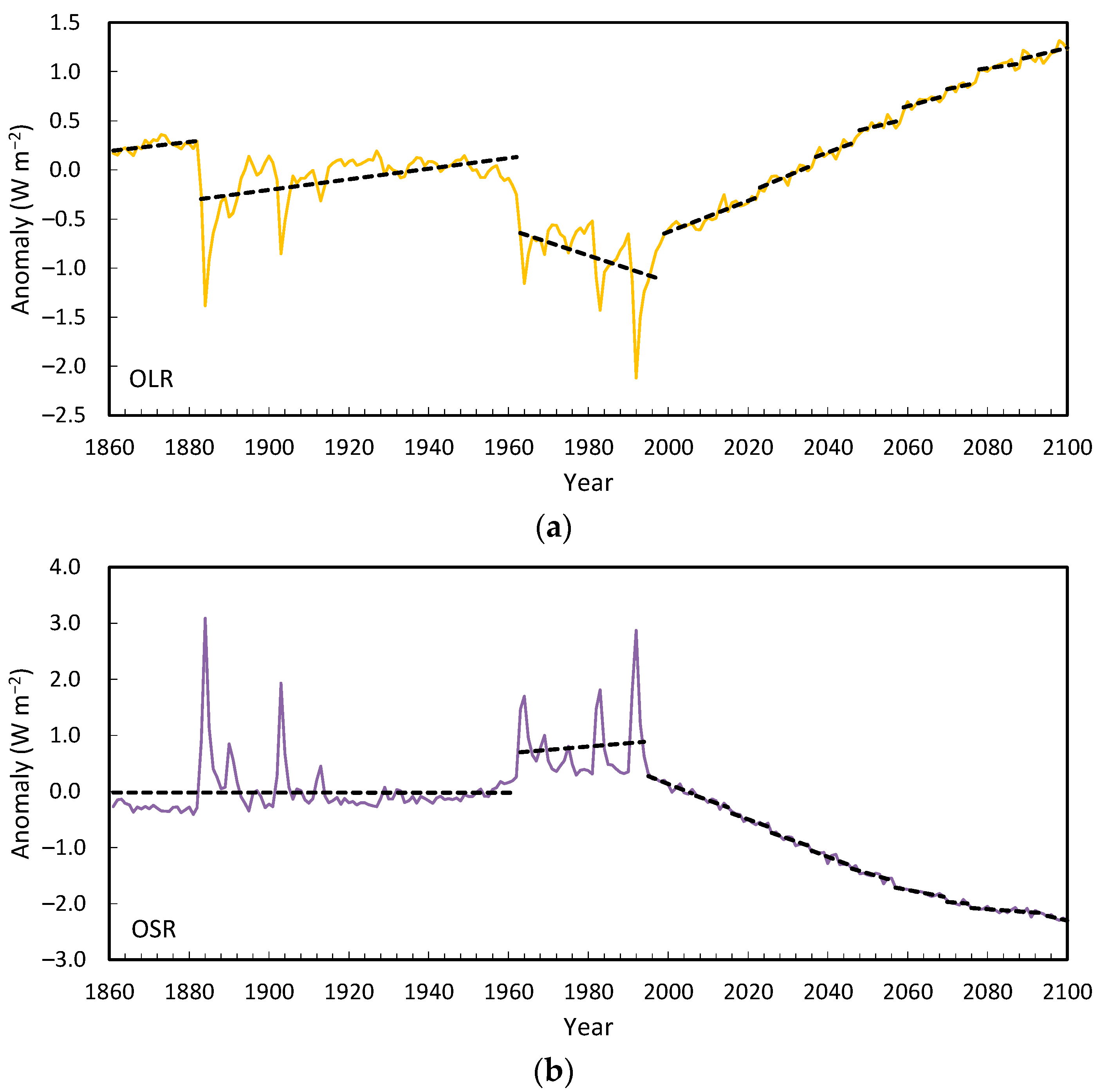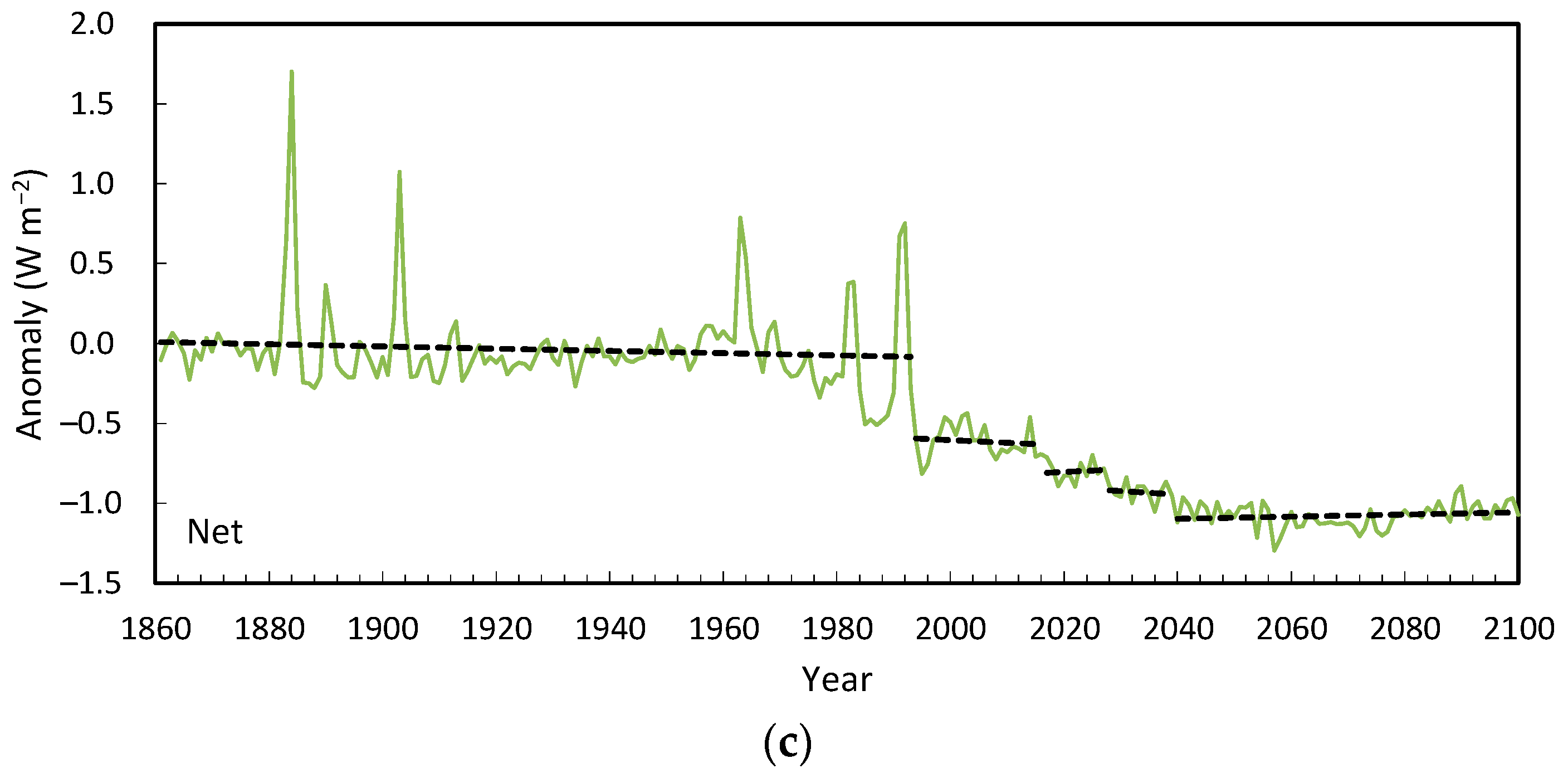4.1. Inconsistencies with the Standard Model
Earth’s energy imbalance (EEI) is widely considered to be the fundamental metric of climate change [
1,
2]. It is a more stable measure than surface temperature when managing the uncertainties surrounding future change [
1,
2,
67]. Hansen, et al. [
5] define EEI as the portion of forcing not yet responded to and Hansen, et al. [
1] consider EEI explicitly as a climate driver.
To track EEI, von Schuckmann, et al. [
2] recommended combining TOA satellite measurements of variability with changing OHC to measure long-term change. Because of the difficulty in measuring TOA energy balance, OHC has been used as a control [
1,
2,
4,
68], but has more recently expanded to a system-wide energy inventory [
8,
10,
11]. OHC remains important because of its large contribution to that inventory.
Equation (1) is one of a set of large-scale indicators that have been developed to track ongoing climate change [
8,
69,
70]. It is a diagnostic tool rather than a physically explicit representation of the change process but represents a deterministic relationship between forcing, energy imbalance and changing surface temperature on annual-to-long-term timescales.
In Equation (1), Net (ΔN) measured in W m
−2 is equivalent to effective radiative forcing less global mean air temperature multiplied by the net total feedback parameter in W m
−2 K
−1 [
4,
71]. Short-term perturbations in EEI TOA are influenced by factors such as ENSO and associated oscillations, along with events such as volcanic eruptions. Decadal perturbations are considered to be influenced by oscillations such as the Pacific Decadal Oscillation, masking long-term change [
6,
72]. The resulting forcing and response energy budget framework is outlined in IPCC AR6 [
8] and utilized in subsequent annual updates of key indicators of climate change [
70,
73].
How additivity and linearity are defined is important. Additivity describes the conversion from ERF to ΔT via radiative transfer. Linearity describes that relationship over a specific time interval. The calculations of the energy budget framework in Equation (1) are considered to be additive and linear [
8]. Linearity requires additivity but also requires homogeneity. If either ΔN or ΔT deviate from ΔF in a systematic way, then the response is inhomogeneous. It can still be additive, but the cause of any inhomogeneities would need to be identified.
According to the standard model, if EEI maps warming in the pipeline [
1], the subsequent warming rate depends on the ongoing sequestration of heat into the deep ocean, represented by ocean heat uptake efficiency. Originally formulated to measure model uncertainties in heat transfer from the shallow to deep ocean [
74,
75], uptake efficiency has evolved to represent the potential warming rate in the atmosphere given the amount of heat transferal to the deep ocean [
76,
77,
78,
79]. When that rate of transferal increases, less is available for warming.
This explanatory sequence complements radiative-convective theory. It follows a causal progression from the conversion of solar radiation via the Planck response, through to changing temperatures using energy balance dis/equilibrium as the control. A small amount of heat trapped by increasing greenhouse gases is assumed to remain in the atmosphere (~1%), with the remainder feeding into the ocean, land and melting snow and ice. The overall warming response is separated into energy storage effects that impede surface warming, the Planck response and subsequent atmospheric and surface feedback effects [
58]. Under this model, deep ocean, surface and TOA processes respond incrementally to forcing; non-gradual responses are due to climate variability.
The results presented here show that while the overall responses in ΔN and ΔT are additive, they are nonlinear over decadal timescales.
Observed OLR detected via satellite spectrometry contains regime changes (
Section 3.1) but the different records are not closely aligned in the way that temperatures are [
19,
23]. HIRS samples more of the atmospheric column than AVHRR and is more highly correlated with reanalysis data. The similarly correlated CERES record has the disadvantage of being half its length.
Reanalysis data also showed shifts in OLR, but they were less reliable than observations. Surface energy fluxes and temperature analyses in the V3 reanalysis (1836–2015) also contained multiple shifts (
Section 3.1.2). Model reanalyses are currently not considered as reliable references for global energy balance [
80]. Climate models also revealed regime shifts in both surface and TOA flux data (
Section 3.2.1,
Figure 8). Regime shifts are, therefore, an inherent aspect of radiative flux data in observations, the reanalysis model and climate model behavior, regardless of their accuracy.
The relationships between OLR, OSR and Net were investigated for both CERES observations and CMIP5 model data. The CERES EBAF-TOA Ed-4.2.1 record 2001–2023 registered shifts in all three variables. Nonlinear behavior was identified, but the record was too short to conclude whether these constituted steady-state regimes.
The complementarity between the three variables in both records was notable. Both annual timeseries (
Figure 6) and latitudinal data at 1° resolution (
Figure 7) from the CERES data showed significant complementarity between OLR, OSR and Net. For the raw data, OSR and Net were most closely aligned, especially in the NH and OLR–OSR N of 30° S. For stationary data, the OLR–OSR relationship was strongest in the NH, OLR–Net in the SH and OSR–Net globally. Most of the change signal was due to changing cloud effects, attributable to rapid increases in SST.
Models from the CMIP5 historical and RCP4.5 ensemble exhibited stable regimes in OLR and OSR during the historical period, but during the 21st century, both records became more trend-like. Net was extremely stable over time for 26 of 27 models tested, due to OLR and OSR compensating for each other. The range of uncertainty for Net in 2100 was about 25% of that for OLR and OSR.
The ensemble members (26/27) maintained equilibrium until 1963–1995, undergoing one to three shifts, with all but one stabilizing by 2039. Most of the initial shifts were triggered by volcanic forcing. The ensemble average for Net showed three distinct shifts, whereas those for OSR and OLR in the 21st century were dominated by trends. The preservation of shifts in an ensemble average when both its inputs show gradual change is overwhelming evidence for self-regulation.
Changes in EEI as reflected in OHC were also more complex than generally assumed (
Section 3.1.3,
Figure 6). Three layers, 100 m, 700 m and 2000 m, were analyzed for regime shifts. These constitute around 89% of the additional heat imbalance [
11,
81]. The top 100 m of the ocean contains roughly 34 times the total heat in the atmosphere and is strongly regime-like (
Figure 6a). Since 1957, the upper 700 m has accumulated 23 × 10
22 J to 2023 and the 1300 m beneath, another 8 × 10
22 J. The rate of accumulation in each has increased only slightly over that time.
However, that heat is not gradually percolating downwards. Year-on-year changes between the upper 700 m and lower 1300 m are inversely correlated (−0.67). The lower layer influences the layer above from year 2–9 at p < 0.05, through oscillations that peak in lag-years 2 and 4–5. The only other interaction of note is between the 700 m and 100 m layers, also oscillatory. This implies that the deeper ocean is acting as a dynamic buffer, with oscillations extending vertically from the depths to the surface. Changes in the 100 m layer are uncorrelated with the other two. Note that the strength of interannual characteristics changes from 2005 due to an expansion of the observation network, which may modify these conclusions, but the overall pattern is robust.
These complex behaviors extend from the deep ocean to the top of atmosphere. They do not support the gradual change imposed by the standard model. This suggests a more complex thermodynamic response to forcing than currently assumed.
4.2. A Complex Thermodynamic Response to Energy Imbalance
The standard thermodynamic view of Earth’s climate is of a single heat engine driven by solar radiation. It is based on the behavior of a classical heat engine, which begins with the idealized, perfect (Carnot) heat engine, modifying it to account for real-world processes such as friction. Driven by increasing heat, the engine will run hotter until it reaches a balance with its external environment, consistent with Equation (1). However, this structure is too simple to produce the results described here.
In classical thermodynamics, the experimenter provides the engine and focuses on its interior behavior, usually beginning with an ideal gas. In a natural system such as climate, where gas, liquid and solids exchange different forms of energy, both the engine and its behavior have evolved within a set of thermodynamic constraints. Any complexity produced is emergent. The differences between these two cases and a summary of the constraints facing the natural heat engine are outlined in
Appendix B.2.
These evolutionary processes have produced a complex set of natural heat engines, all open. The main two are the radiative and dissipative engines. The radiative engine represents radiative exchange between Earth and space, and the dissipative engine is nested within that. They share the conservation of energy, but the dissipative heat engine also conserves mass and angular momentum [
82,
83,
84].
The radiative engine is governed by the physics of radiative transfer, the amount of which constrains the dissipative engine. The upper boundary of the radiative heat engine is the nominal top of the atmosphere where the difference between incoming and outgoing radiation is at a minimum (zero if at equilibrium). Due to different heights of emission, this boundary is highly attenuated; for satellite measurements, a height of 20 km has been chosen [
85]. The radiative engine performs no work itself, but the dissipative engine does. This raises the question as to whether the top of the atmosphere forms a strong enough boundary for EEI TOA to be considered as a climate driver, or whether the internal energy imbalance within the dissipative engine is what matters most.
The upper boundary of the dissipative heat engine is constrained by meridional heat transport, i.e., mass transport described by general circulation. To maintain equal amounts of energy loss from both hemispheres, ocean and atmospheric heat transport compensate for each other latitudinally [
86,
87]. Within this limit, modeled variations in total heat transport between glacial maximum and 4 × CO
2 climates vary by only 2% [
88]. The lower boundary of the dissipative engine intersects with land, the biosphere and deep ocean—interacting with earth system processes that exchange energy on longer timescales [
84,
89].
The two have different energy profiles. For the radiative engine, incoming solar radiation averages 340 W m
−2 and net surface radiation is 104 W m
−2 [
90]. The boundary between the two engines is complex, taking place at different altitudes, latitudes and seasonally, so the 104 W m
−2 is nominal.
The dissipative heat engine is a far from equilibrium chaotic system [
89,
91,
92,
93,
94], whose complexity arises from the interplay of positive and negative feedbacks, instabilities and saturation mechanisms [
95]. Like any flow system, it is restricted by its narrowest point, which is the maximum available power for meridional transport of heat from regions of excess to the higher latitudes.
Kleidon [
84] estimated the global average heat transport to be 48 W m
−2 with a mean rates of power generation of around 2 W m
−1 in the atmosphere and 1 mW m
−2 in the ocean. This is consistent available potential energy as conceptualized by Lorenz [
96,
97] and quantified by Oort [
98]. It makes up about 2% of net surface radiation (104 W m
−2 [
90], consistent with estimates from reanalyses [
99]. The Lorenz model separates kinetic energy into overturning (or zonal) and eddy kinetic energy. Measurements of each show that the power generated during overturning processes is largely cancelled out while the eddy (meridional) power is retained [
100].
From an engineering perspective, a 2% efficiency rate is very low, but from an ecological perspective, the dissipative heat engine is very efficient. It has evolved in such a way to use the momentum from rotation, tidal effects, gravity and energy flows from friction, the biosphere and the hydrosphere to maintain climate in steady state, achieving a lot with very little. This is maximum flow efficiency, moving the greatest possible mass with the least resistance while expending all available energy [
101].
A key justification for the standard model is that the single heat engine is close to thermodynamic equilibrium. This assumption is based on the energy profile of the radiative engine. The estimated historical ERF of 2.72 ± 0.76 W m
−2 in 2019 [
8] is 0.8% of incoming solar radiation (340 W m
−2). This is small. However, the radiative engine performs no work.
Historical ERF exceeds the maximum power limit of the dissipative heat engine (~2 W m−2), which performs all the work. Adjusted EEI TOA from CERES 2012–2023 is 1.09 ± 0.11 W m−2, over half this power limit. Because it can only change marginally, this maximum power limit acts as a choke point.
The close-to-equilibrium argument is used to justify the application of the fluctuation–dissipation theorem [
95,
102,
103]. Linear response theory holds that the response to an external perturbation is expressed in terms of the fluctuations of a system in thermal equilibrium [
104]; i.e., the responses to small external and internal perturbations are identical. The main application of this theory is in the use of the signal-to-noise model.
However, when forcing produces a nonlinear response, Ruelle’s [
105] requirements for the fluctuation–dissipation theorem to hold, fails: “for a small periodic perturbation of the system, the amplitude of the linear response is arbitrarily large”. This is an appropriate description for forced regime shifts in the dissipative heat engine. In mathematical terms, the response is inhomogeneous as a function of time.
The radiative and dissipative engines also have different relationships with entropy. Entropy can be addressed in two ways: entropy generation through thermodynamic processes and entropy as a state variable. The Clausius definition for entropy production is the amount of heat unavailable for work. The Boltzmann–Gibbs definition is the number of microstates available to a macrostate [
106,
107]. Entropy production within climate has been characterized as internal and external [
108,
109,
110], which aligns with the radiative and diffusive engines. For Boltzmann–Gibbs entropy, a nonequilibrium dissipative system will evolve towards its maximum entropy at steady state.
Regarding external entropy production, the conversion of incoming shortwave solar radiation to outgoing shortwave scattered and longwave radiation increases the entropy of the universe [
84,
110]. A warming climate, therefore, increases external entropy.
In the dissipative engine, steady-state entropy decreases with warming. This does not violate the second law because the engine is open and external entropy is increasing. The preindustrial climate, with its capacity to shift both warmer and cooler, had higher entropy than today’s climate, which can access fewer microstates because it is being forced in one direction. Forcing decreases the internal entropy of the climate system because it becomes more organized. Because the dissipative system is already at its maximum flow efficiency, any response to forcing requires a change in dissipation modes within the maximum power limit.
Shifting to a warmer climate incurs a cost that results in greater irreversibility, sometimes referred to as irreversible entropy [
111]. Internal entropy production is better viewed collectively as resistance, which is subject to conservation laws. This includes the irreversible entropy associated with friction and the hydrological cycle [
112,
113,
114]. Because meridional heat transport is fixed, increases in dissipation need to switch from low energy density–low resistance modes, to higher energy-density pathways with greater resistance (e.g., from the ocean to the atmosphere and from dry to moist atmospheric transport). The estimated power limit for large-scale convection is 2 W m
−2; for dry convection and sensible heat flux from land, it is 4 W m
−2, and for moist convection, it is 7 W m
−2 (data from Kleidon [
84]).
Constrained by the additional 5 W m
−2 cost that accompanies moist convection, only 2–3% moisture per °C of warming being is added to the observed climate, rather than the potential 7% estimated by the Clausius–Clapeyron relationship [
115,
116]. Self-regulation requires a balancing act between all of these processes. These trade-offs dictate the transient warming rate, not the rate of ocean heat uptake efficiency. The latter is an intermodel uncertainty, not a real-world constraint.
In shifting to warmer dissipation modes, climate is compelled to accommodate higher levels of irreversibility. This acts as a drag on the system. It is similar to the metabolic adjustments biological systems have to make in order to maintain elevated levels of dissipation [
117].
4.3. EEI and Self-Regulation
OLR and OSR are generated by two different energy pathways, so the complementary relationship between the two in conserving total energy can only be achieved through self-regulation, where a change in one is compensated by the other in maintaining EEI TOA in a given state. Even though the presence of steady-state regimes in EEI TOA could not be confirmed for observations, the strong model consensus is a robust result.
The presence of steady state regimes has been confirmed for air temperature, atmospheric moisture and OLR (observations and models); surface fluxes (reanalyses and models); shallow ocean temperatures (observations); and OSR and Net (models). Other forms of self-regulation are interhemispheric exchange to balance outgoing energy and the relationship between OSR and OLR in maintaining that balance in net spatially and temporally. A further possibility involves EEI, where the oscillating nature of heat build-up between the mid-level ocean (to 700 m) and deeper ocean suggests that active connections exist between the deeper ocean and top of the atmosphere.
The trade-off between OLR and OSR in maintaining Net indicates additional self-regulation that is not immediately apparent, namely, spatial regulation within the climate network. Feedback effects from surface warming vary widely, especially over the ocean, ranging from strongly positive to neutral-negative. Locations where regime shifts are strongest can, therefore, influence warming rates and patterns, influencing the relative contributions of OLR and OSR.
Appendix B.2 contains a mini review of these effects, including evidence drawn from this study.
Recent observations show that the response in EEI TOA is dominated by reduced OSR (increased absorbed shortwave radiation) due to cloud feedback, rather than increases in OLR. OLR is a product of mass transport, so it comes at a cost. The locations of greatest increase in OLR in
Figure 5b are convective rather than meridional. The same processes leading to increased OLR also lead to greater moisture transport, providing the potential to change cloud characteristics, resulting in the strong complementarity between OLR and OSR.
Therefore, even though moisture increases come at the cost of greater irreversibility, cloud feedbacks provide the additional capacity to absorb shortwave radiation as a bonus. This is mainly driven by changing cloud amounts, especially low-to-mid cloud [
57], with the resulting feedback dominating the amount of realized warming. Therefore, the Planck response increasing OLR and feedback manipulating OLR are coupled.
These changes involve the self-regulation of patterns of change in SST influencing cloud amounts and cloud type [
57], reflected in levels of sensitivity and OSR. This is the most unexpected finding of the project. The idea that cloud amounts and characteristics can be manipulated to counterbalance OLR and OSR in order to stabilize Net is radical. However, models achieve this even when their estimates of OLR and OSR are wildly wrong (
Figure A2), showing how strongly boundary conditions and system limits influence both model and real-world performance.
The dissipative heat engine regulates two types of equilibrium:
Internal equilibrium within the dissipative heat engine, where a steady state between the coupled ocean and atmosphere is maintained at the maximum possible entropy subject to the amount of forcing. This state is buffered within critical limits.
External equilibrium/disequilibrium expressed as EEI TOA (Net). This also is maintained in steady state, but if the accumulation rate of heat within the climate system exceeds the transient warming rate, EEI TOA can shift further negative.
In relieving forcing pressure, warming provides a negative feedback, whereas a larger deficit in EEI TOA provides a positive feedback. With sufficient forcing (e.g., RCP8.5), shifts in temperature become so frequent they merge into a curve [
19]. These shifts act as gear changes. Shifts in dissipation rates cause the engine to run ‘richer’, with greater energy density and irreversibility, reducing steady-state entropy. Shifts in EEI TOA represent the inability for that warming to relieve the increasing internal energy imbalance, showing the limits of self-regulation. EEI TOA does not represent a physical limit in itself but reflects the status of the system in managing internal energy imbalance, measuring the difference between demand to return to equilibrium and supply of response within its different constraints. The oscillating relationship between the mid-level and deep ocean OHC suggests self-regulation within the climate system is four-dimensional, comprised of three spatial dimensions and one of time.
The tension between decreasing entropy within the dissipative heat engine as it warms and increasing entropy in its radiative output is similar to that nominated by Schrödinger for biological systems [
118,
119]. The capacity to self-regulate between the material and radiative aspects of climate to main steady-state regimes mirrors the metabolic characteristics of biological systems that utilize biochemistry. This suggests the evolutionary processes behind the development of complex natural phenomena such as the climate system precede those associated with living systems.
